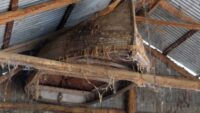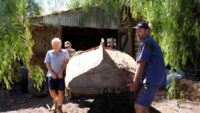 The wooden lifeboat that carried the crew to safety after their ship wrecked off the western coast of Australia in 1891 has been found intact in the rafters of a hay shed. Archaeologist Bob Sheppard was taking a tour of the old farm’s historic outbuildings. John Grigson showed him the nifty boat in the rafters and told him it was the lifeboat of the Maid of Lincoln. The remains of the Maid were never found, so this is the only known artifact from the shipwreck and it is in excellent condition.
The wooden lifeboat that carried the crew to safety after their ship wrecked off the western coast of Australia in 1891 has been found intact in the rafters of a hay shed. Archaeologist Bob Sheppard was taking a tour of the old farm’s historic outbuildings. John Grigson showed him the nifty boat in the rafters and told him it was the lifeboat of the Maid of Lincoln. The remains of the Maid were never found, so this is the only known artifact from the shipwreck and it is in excellent condition.
The Maid of Lincoln was a 12-horsepower wooden steamer built in Port Lincoln in 1885. It primarily served harbor duty for its first few years. In 1889 it caught fire while at anchor in South Bay and was heavily damaged in the conflagration. It was repaired and put back to work.
It wasn’t fire damage that brought it down in the end. The ship set out on April 11, 1891, carrying a load of guano from the Abrolhos Islands, rich seabird nesting sites, to Bunbury. Its captain, William Millar, ordered changes to the course heading but stayed below deck so much that he didn’t realize it was getting to close to the coast and that the visibility was too poor for the helmsman to adjust. At 2:00 AM, the Maid of Lincoln struck a reef eight miles south of Jurien Bay off Hill River and quickly sank.
The captain, a half-dozen crew members and one stowaway who only made his presence known when the ship was rapidly filling with water, managed to get on the ship’s lifeboat and launch it before the ship went down, but they didn’t have the time to salvage any supplies. Half of the crew didn’t even have the time to put shoes on. When they made it safely to Jurien Bay, the shoeless survivors stayed behind on the beach and the other half of the party went inland to Cockleshell Gully where they reached the Grigson farm. John Grigson’s grandfather transported the refugees to Geraldton on by horse and cart. Captain Millar gave the lifeboat to Grigson to thank him for his aid.
The family used it as a fishing boat and kept it out on the veranda. Around 70 or 80 years ago, they retired it permanently and stashed it up in the shed they’d built in 1901. It has been peacefully collecting spider webs ever since. The rafters are in worse condition than the boat. Devoured by white ants, they are not what you would call structurally sound at this point, and the boat was at risk of collapse.
 Removing the boat was a delicate operation. An archaeologist and expert on ropes was enlisted and he designed a cunning rig made of old ladders, fencing and ropes to carefully raise the boat off the rafters and then lower it to the ground. They didn’t know how heavy it was or how it might react to the pressures of transport, but the old lifeboat proved remarkably sturdy yet. The team was able to remove it intact without incident.
Removing the boat was a delicate operation. An archaeologist and expert on ropes was enlisted and he designed a cunning rig made of old ladders, fencing and ropes to carefully raise the boat off the rafters and then lower it to the ground. They didn’t know how heavy it was or how it might react to the pressures of transport, but the old lifeboat proved remarkably sturdy yet. The team was able to remove it intact without incident.
For now it resides in a weather-proof storage shed. Sheppard hopes to find a permanent home for it in a museum. The Grigson family has stipulated that it must remain in Jurien Bay for the community to enjoy this rare piece of its maritime history.
“White ants” is a rather misleading term for termites.
According to ant literature, there are only red, black, and brown ants. Ants are beneficial to the ecosystem in general because they aid in natural processes such as pest control, decomposition, and soil aeration. Ants may be pests in and of themselves, but they’re also often blamed for the mischief of other insects and the harm they do. On the other hand, Termites are wood-consuming insects that can cause severe damages to homes and businesses. They usually live in large colonies and can do a lot of harm in a limited period of time to wood and wooden structures. Because of their potential to inflict significant damage that can cost thousands of dollars in repairs, these pests are one of the most feared by home and business owners. Therefore, though the term “white ants” is widely used the author of this blog should have done some research before in including it since the “white ants” name and description are misconceptions that are used to identify termites; which are not the same as ants nor are they closely related to them. So, the use of the term “white ants” can be very misleading as it can either confuse those that never heard of the name and lead them to believe that there are four types of ants (i.e., Red, black, brown, and white ants) or can make others who do not have much knowledge on termites or what they are but know that they are called white ants to believe that they are a type of ants or are somewhat closely related to them. Additionally, though the blog gave a nice history on the Maid of Lincoln and on the ship’s lifeboat and when it was used. Since the lifeboat was the main topic more information such as the type of wood used to build the lifeboat, the exact year the lifeboat was built, and as well as the dimension of the lifeboat should have been stated in the blog. Also, since this lifeboat is part of history I would have enjoyed seeing more pictures of the lifeboat and close-up images of its condition as mentioned in paragraph 5 of the blog. Furthermore, another thing that the blog failed to provide was images of the Maid of Lincoln ship. This would have helped the readers/audience to see exactly what the ship looked like since the blog provided a lot of history on it. Lastly, in the blog not only the number of crew member that was on the lifeboat after the maid of Lincoln struck a reef and started sinking on April 11th, 1891, should have been provided but their names should have been given as well since they were part of this historic event and it would have been nice to know about them or to acknowledge them.
While I agree with Takiyah Nurse that more information and details would have been nice I do not agree that Livius was negligent in not including them. Livius is limited, as we are, by the information released on to the internet by the individuals and organizations releasing information about a discovery or development, often in the form of a press release. Although not an issue here, translation from the original language to English can be an issue.
If the common Aussie term for termite is “white ants” it is not incumbent on Livius to the research to use the more correct term.
Similarly, if the finders did not release details about the lifeboat or the crew it is largely impossible to add that information. I suspect that the date of construction of the lifeboat is lost to time. It was probably purchased at the time of the construction of the Maid of Lincoln, either new or used. Analysis of the wood may reveal if it was made from wood native to Australia or somewhere else.